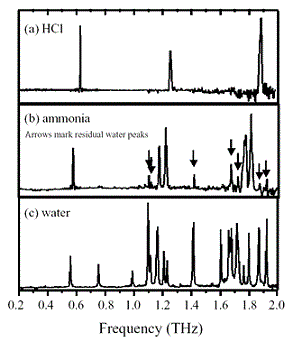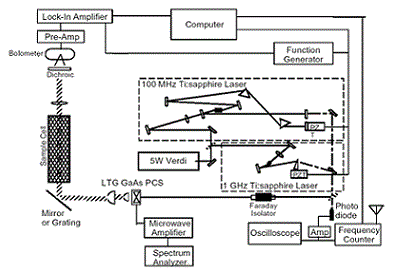Femtosecond Sources
All THz sources depend in one way or another on the production of current pulses whose time scale is of the order of the reciprocal of the frequency being generated. Since the reciprocal of 1 THz is 1ps, it is natural to turn toward femtosecond lasers as a driving source for these current pulses. Two general schemes have evolved: one of which uses the femtosecond pulse to generate a broad spectral pulse and Fourier Transform techniques similar to those employed in FT-FIR systems are used to achieve spectral resolution; and another which uses a train of femtosecond pulses to produce a high resolution comb of frequencies which is tuned by scanning the mode-lock frequency of the drive laser. Both use photoconductive switches to demodulate the optical pulse to provide the THz radiation [1].
Figure: THz Spectrometer. Schematic of fem-
tosecond THz time-domain spectrometer.

Figure: THz Spectrometer. Schematic of fem- |

Figure: Gas Phase Spectra. Gas phase spe- |
Higher resolution than the ~1 x 10-2 - 1 x 10-3 shown can be achieved by use of a lower pressure gas and a longer scan in the delay line, although at the expense of signal strength as a smaller fraction of the THz pulse interacts with the sample.
Figure: Femtosecond Demodulation System. Femtosecond
demodulation system for high resolution spectroscopy in the THz.

Figure: Femtosecond Demodulation System. Femtosecond |
Figure: CO Transition. Recording of the J=10-11 transition |
If one adopts as a nominal average power for a THz-TDS system of 100 nW – 1µW [5], a bandwidth of 1 THz, a pulse length of 1 psec, and a repetition rate of 100 MHz (duty cycle of 10-4 – peak power of 1 – 10 mW), the higher powers corresponds to a brightness temperatures of 105 and 109 K for average and peak temperatures. Look at and cite our APL.
For relatively low-resolution, broadband spectroscopy both THz-TDS and FT-FIR systems are appropriate, with their resolution being set by the distance traversed by a mechanical delay line. Since thermal sources have powers that grow with frequency as ~ 6db/octive and THz-TDS systems have sensitivites that drop as ~12 db/octive, there should be a sharp, implementation dependent, frequency transition between the relative sensitivities of the two. At relatively high resolution there is considerably more FT-FIR than THz-TDS results in the literature. Figure XXXX shows an example. For a comparison with high resolution electronic source see Figure:HSSH Ground State in the section on BWO sources.
References
- Picosecond photoconductive hertzian dipoles Appl. Phys. Lett. 45, 284-286 (1984). Google Scholar
- Gas sensing using terahertz time-domain spectroscopy Comput. Eng. 67, 379-390 (1998). Google Scholar
- Chemical recognition of gases and gas mixtures using terahertz waves Opt. Lett. 21, 2011-2013 (1996). Google Scholar